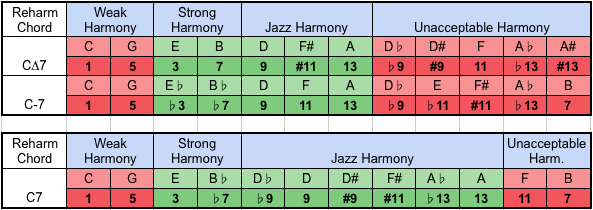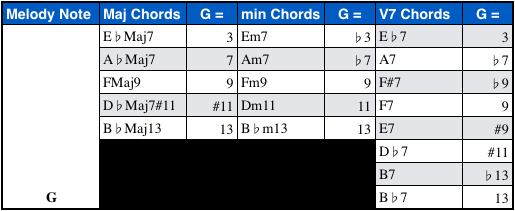Make it Jazzy
In this lesson and the below video, we will explore how you can turn any song into a Jazz song by using a number of techniques, including Reharmonization (or with an ‘s’).
Many of the concepts we learned in previous lessons can be applied to any song to make it sound ‘jazzy’. For example, we can take any old song and apply the following techniques:
- Play 7th Chords
- Extend the chords (play 9th and 13th chords)
- Alter the chords
- Add Passing Chords
- Choose appropriate Jazz Chord Voicings
- Embellish the melody (add in a little improvisation and a few ornamentals)
- Reharmonization (see below)
Applying each of these ideas allows you to ‘jazz up’ a song; and each gives you differing levels of ‘jazziness’. From barely jazzy (using 7th chords) to very jazzy (reharmonization). But by using and combining the above techniques you can turn literally any song, whether it be pop, classical, country, whatever, into a Jazz song (or at least a jazzy sounding song).
Reharmonization (or How to turn any Song into a Jazz Song)
Reharmonization is essentially just a fancy word for chord substitution, but it involves substituting an entire chord progression rather than an individual chord. Below we will discuss the general rules and underlying theory of how and why chord substitutions work. This will allow us to create our own chords when reharmonizing a song, rather than relying on standard and often overused chord substitutions (which don’t always necessarily work).
When we reharmonize a song, we keep the same melody but change the chords to create a jazzy harmony. To understand reharmonization we need to understand the following concepts:
- Key Melody Note – This is the most important note in each bar. As such, you structure your harmony (chord) around that note, treating all the other notes as passing notes (i.e. notes that are NOT important to the harmony). Choosing the Key Melody Note of each bar is somewhat subjective, but the factors that determine whether a note is the Key Melody Note are:
- The first note of each bar is more important than later notes
- Notes played on-the-beat are more important than those played off-the-beat
- Longer notes are more important than shorter notes
- Repeated notes are more important than non-repeated notes
Reharmonization General Rule: You can alter any note in the chord, EXCEPT the key melody note. This means you CAN alter the root, 3rd and 7th – so can alter the tonality and the quality of the chord.
- Acceptable Harmony – We have already learned in previous lessons that not all notes are equal. Some notes sound strong when played over a chord (Guide Tones), some notes sound pleasant and complement the sound of a chord (Available Tensions), while some notes sound weak and dissonant (Avoid Notes). Well, I’ve defined ‘acceptable harmony’ as ‘guide tones’ (3rd & 7th) plus ‘available tensions’. These are the notes that sound good over a particular chord. I have allocated every note into the following categories:
- Strong Harmony = Guide Tones
- Weak Harmony = Root & 5th
- Jazzy Harmony = Available Tensions
- Unacceptable Harmony = Unavailable Tensions/Avoid Notes
Acceptable Harmony = Guide Tones + Available Tensions
Below are the Acceptable Harmonies for a Maj7, m7 and V7 chord.
Acceptable Harmony

Ok, so now let’s do the same exercise but in reverse. Instead of taking a chord and finding all its acceptable harmonies, let’s take a note and find all the chords where that note is an acceptable harmony.
Chords where ‘G’ is an Acceptable Harmony

Above we have all the chords that have G as an acceptable harmony. This means when reharmonizing a bar where the Key Melody Note is ‘G’, you can pick literally any one of these chords. Playing the note G over any of these chords will sound good and strong and pleasant.
Reharmonization General Goal: Substitute in chords where the key melody note is an acceptable harmony over that chord.
Google Doc
Below is an embedded Google Doc which outlines all the possible reharmonization (substitute) chords for the Maj7, m7 and V7 chords for all 12 notes. You’re welcome to export it to Excel. To do this:
- Go to the Google Doc by clicking here
- Press ‘File’
- Select ‘Download as’
- Select ‘Microsoft Excel’
Where to Next?
Ok, so now we have chosen a chord based on the key melody note in a particular bar. Where do we go from there? What chord should we pick next? Here are a couple general rules to follow:
- Pick any chord where Key Melody Note is an Acceptable Harmony
- Move to the next chord in a structured way, either:
- Chromatically (half step) – E7 to E♭Maj7
- Diatonically (whole step) – Em7 to Dm7
- Circle of Fifths – B7 to Em7
- Choose chords that increase and then decrease tension
- To increase tension – use higher extensions and alterations (e.g.♭13)
- To decrease tension – use Guide Tones (3rd & 7th) and lower extensions (e.g. 9)
Using reharmonization (and the other aforementioned techniques) will allow you to turn any song into a Jazz song and give you differing levels of jazziness. But to truly hear how and why using the above techniques makes a song sound jazzy, make sure you watch the below video. In it I take a famous pop song (Let It Be) and ‘jazz it up’.
And in the next lesson we will discuss Reharmonization in a bit more detail and using more chord types.
Conclusion & Some Philosophical Ponderings
A few concluding remarks:
In the above lesson we changed the chord in order to fit the melody. However, you can also change the melody to fit the chords. I’m sure you can imagine, that if you do this your options are almost limitless. This means you can pick literally any chord, and if the melody note doesn’t fit (i.e. the melody is not an acceptable harmony) you can just change the melody (by sharpening, flattening or omitting it). This is often done when a musician favours the structure of the chord progression over the melody. This is a useful idea to employ over things like Coltrane Changes or over II-V’s.
And finally, the ‘acceptable harmonies’ I’ve mentioned are what is currently ‘acceptable’. But never forget that what is ‘acceptable’ changes over time. In the Middle Ages the tritone was the Diabolus in Musica; in the early 20th century Maj7 intervals were not often used (with musicians preferring the Maj6 chord). So, don’t be afraid to use some unacceptable harmonies, and just see how it sounds. This is, after all, how music (and everything else) evolves – by people breaking rules. Viva la revolución!